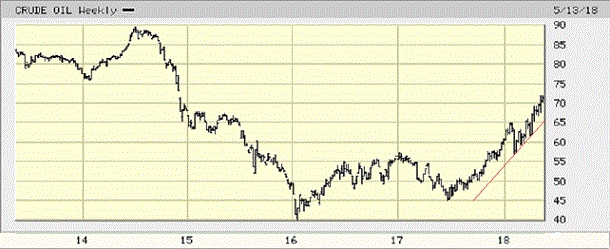While it may appear to most investors that important market movements and trends appear without warning, this is rarely, if ever the case. Astute observers will note irregularities and important trend changes long before the mainstream media starts reporting them to the broader public. The overnight collapse of some mortgage companies in December 2006 was an early warning sign of the impending Credit Crisis that didn’t peak until the fall of 2008. It got little media attention at the time, however. May 15, 2018 could turn out to be another landmark day warning us that a big change, this time a new era of inflation, is on the way.
The U.S. Federal Reserve has little concern about inflation at the moment. It rarely does before inflationary forces become entrenched and almost impossible to eradicate. Currently, the Fed is focusing on the neutral rate of interest, which consensus has at 2.5% for its funds rate. Supposedly, once that rate is achieved, which could be as early as the end of this year, the economy and rates will be in balance and everything will just coast along in the best of all possible worlds. Left undiscussed is how the central bank’s policies can control what takes place internally in the U.S. in a substantially globalized world.
The bond market stated its disagreement with this view on May 15th. Yield on the 10-Year US Treasury traded as high as 3.095%. This confirmed a double bottom was made in 2012 and 2016 by trading above the 3.04% high between the two lows. Far more importantly, this is the first higher, high since the yield peaked and started falling in 1981. Yields, of course, rise with inflation. The significance of the end of a 37-year trend cannot be understated, especially since the fall in interest rates has acted as support for rising stock prices during this period. The opposite will act to keep stocks down, and this is likely to be the case for 20+ years since that is historically how long interest rate trends have lasted in the U.S. You can read more about this in my article: “Long-Term Trend In Rising Yields Is Just Beginning.” See: https://bit.ly/2wKA2Kt.
While the 10-Year Treasury yield was reaching near seven-year highs, WTI and Brent oil were hitting three and a half year highs. Nothing is more inflationary than rising oil prices. Few things are transported without fuel derived from it. Approximately 6,000 products are manufactured using petroleum. Modern agriculture is impossible without it. The price of oil affects the price of everything else. While the current price rise is being attributed to the U.S. threatening Iran with sanctions, the real story is that rising demand is outstripping supply. Oil has been moving up since early 2016, and the rate of increase has steepened since mid-2017, long before the current situation with Iran emerged. Once supply and demand becomes tight in the market, it can take a few years to rebalance them. A temporary peak may be reached this summer because of seasonal demand factors, but it will only be temporary.
The other harbinger of inflation is a selloff in emerging market currencies – the weakest links in the global financial system. Argentina and Turkey are struggling to prevent devaluation, but they are only the current worse case scenarios (they are power houses compared to the Iranian rial, the Indonesian rupiah, the Vietnamese dong and the Venezuelan bolivar). The Brazilian real hit a two-year low and the Mexican peso a one-year low on Tuesday. The South African Rand fell 2.5% and the Russian Ruble 1.4%. No region of the globe is immune from emerging market currency weakness. Considering that an alternative definition for inflation is a currency losing its value, it looks like a wave of inflation is about to wash over the world’s developing economies.
A confluence of events has created a falling and then low inflationary environment for the last three decades. Globalization, which has allowed cheaper labor to be accessed to do the world’s manufacturing, and falling commodity prices have been the primary driving forces behind it. Both of these trends seem to be exhausted for the time being, and the pendulum is starting to swing the other way if we are to believe what the market is telling us.


